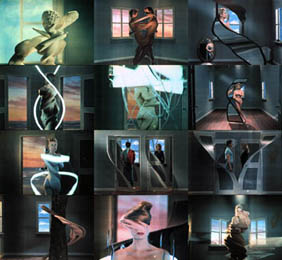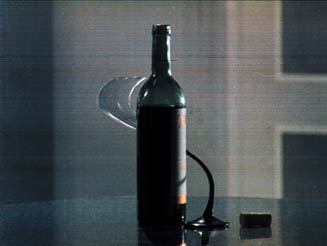- Zbig Rybczynski, by Jacques Kermabon, Zbigniew Rybczynski, lêautre dimension, in "Bref," May-July 1990
–Rybczynski uses images like geological layers. He does not play with the image as a background/form, but as a geological mound. For him, each line becomes a system that can be isolated, the way a geologist approaches and analyzes each single stratum. That slippage and the baroque elements are truly the product of a geology rather than a geometry of the image. The horizontal lines are to him what the layers of sedimentation are to a geologist and this, in my opinion, is highly original. He no longer plays with the plots, but with the horizontal lines, like a musician that lets his notes glide through the musical staffÄ Deleuze would like that, the foldÄ ah, yes, that there is truly the fold!”
- Paul Virilio, Le phþnomúne Rybczynski, –Cahiers du Cinþma,” January 1989
–In The Fourth Dimension, Rybczynski discovered that the raw material he was working with was not made up of dots, but lines. Lines whose center, as Deleuze would say, quoting Leibniz, •is never a part, but a simple extremity of the line.ê Lines whose êsmallest element is not the dot, but the rhizome.ê [Ä] With the help of a computer programmed to re-film an image 480 times, line by line, Rybczynski folds the bodies and the backgrounds infinitely. He unfolds time in space (the matter-fold is matter time, explains Deleuze): each line, at most, could belong to a different time. Swirling lenses, dizzying twists, inverted plaits, entangle themselves before our bewildered eyes [Ä]. The Fourth Dimension begins with a reference to the Bible: a large open book unfolds its wings, wrapping itself around a candle, a symbol of the primordial light, born of the word Creatoress (And God saidÄ Let there be lightÄ). Then a primitive mass, which unfolds itself slowly. Later, a man walks around a rock. The woman around the man. Then the light (neon filaments) around the original couple. Soon afterwards, their twists conjure up serpentine movements, hence the Evil One, he who divides. And the apple of betrayal, in a corner of the frame, shows that we have not made a mistake, that we have returned to the earlier era of the original sin.”
- Jean-Paul Fragier, Z. Rybczynski et G. Hill: la ligne, le point, le pli, –Cahiers du Cinþma,” January 1989

Supersize photo
The Fourth Dimension shows a couple (Adam and Eve) and various objects, simultaneously, in time, space and movement. |
|
–As they slowly move, the two figures assume a strange and spiral form, as if they were two snakes. Actually, the two are standing still, and are moved by the platforms that shift them horizontally and around each other: the original image is treated by a digital system that caused each single line that makes up the frame to be •re-readê more than four hundred times. This means that inside each frame, each line, in respect to the movement of the characters, undergoes delays, so that if one of them moves rectilinearly from left to right there is a progressive delay, since the visual movement goes from top to bottom of that same direction. [Ä] The time-space of the video image, modified by this visual device, takes advantage of the concept of delay and of temporal expansion, actually due to a repetitive process of the perception of the single lines of the frame. – - Alessandro Amaducci, Segnali video. I nuovi immaginari della videoarte, GS Publishing Company, Vercelli 2000 |
